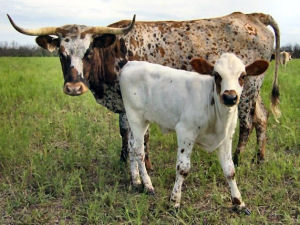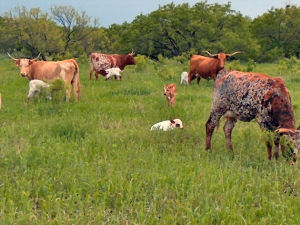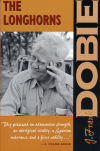
HOME
INTRO
SYMBOLS
ALMANAC
ECONOMY
GEOGRAPHY
STATE MAPS
PEOPLE
FORUM
NEWS
COOL SCHOOLS
STATE QUIZ
STATE LINKS
BOOK STORE
MARKETPLACE
NETSTATE.STORE
NETSTATE.MALL
GUESTBOOK
CONTACT US


Tweet
Double click any word in document for definition.
Texas State Longhorn Herd

Texas State Longhorn Herd:
Texas Parks and Wildlife Department's Foundation Herd
Photograph: © Texas Historical Commission.
It's said that, due to changing times, the Texas longhorn was on its way to extinction by the 1920s. Only a few small herds could be found.
Along with a contingent of Texas Forest Service men, Will C. Barnes collected a small herd of breeding cattle and shipped them off to the Wichita Mountains Wildlife Refuge in Oklahoma.
Following in Barnes' footsteps, J. Frank Dobie, with the help of former range inspector Graves Peeler, began to collect small herds to be placed in Texas state parks.
The Wichita Mountains herd grew well and soon numbered several hundred and the Forest Service began holding annual sales. The rebirth of the longhorn was under way.
In 1964, the Texas Longhorn Breeders Association was formed.
On May 13, 1969, Senator David Ratliff introduced Senate Concurrent Resolution No. 79.
Senate Concurrent Resolution No. 79
WHEREAS, The 61st Legislature wishes to recognize and pay tribute to the foundation herd of Texas longhorn cattle owned and managed by the Texas Parks and Wildlife Department at Fort Griffin State Park; and
WHEREAS, This herd has been carefully managed in the past few years, which has resulted in its current recognized status of quality; and
WHEREAS, The Texas Parks and Wildlife Department is a member of the Texas Longhorn Breeders Association; and
WHEREAS, This herd now exceeds one hundred (100) quality Texas Longhorns, most of which have been branded and registered; and
WHEREAS, This herd contains the only set of twin calves ever registered by the Texas Longhorn Breeders Association, and is the herd from which the famed Bevo mascots are bred for The University of Texas at Austin; and
WHEREAS, The Texas Parks and Wildlife Department owns the famed registered lone star brand which identifies this herd; now, therefore, be it
RESOLVED, That the Senate of the 61st Legislature, the House of Representatives concurring, recognize the Texas Parks and Wildlife Department's foundation herd of Texas Longhorn cattle as the official State of Texas Longhorn herd; and, be it further
RESOLVED, That a copy of this Resolution be prepared for the Texas Parks and Wildlife Department for display in an appropriate location at Fort Griffin State Park.
It was approved in the State Senate on the same day it was introduced! The next day, May 14, 1969, the resolution passed in the State House of Representatives!
When Governor Preston Smith signed Senate Concurrent Resolution No. 79 on May 23, 1969, the longhorn herd residing at Fort Griffin State Park became the official State of Texas longhorn herd.
But more honors awaited the Texas longhorn. In 1995, the longhorn was adopted as Texas' official state large mammal.
NOTE: The Fort Griffin site is no longer a state park. The site was transferred to the Texas Historical Commission and is now officially known as Fort Griffin Historic Site.
... effective January 1, 2008, Fort Griffin State Historic Site was transferred to the Texas Historical Commission (THC) from Texas Parks and Wildlife Department (TPWD) and is no longer considered a Texas State Park. The State Park Pass and Parklands Passport are statewide passes for parks operated by TPWD. Fort Griffin State Historic Site is managed by the THC.
("Texas Historical Commission")
The official state herd is now jointly managed by the Texas Historical Commission and the Texas Parks and Wildlife Department. The herd is based at Fort Griffin Historic Site--formerly Fort Griffin State Park--though portions also reside at Copper Breaks, San Angelo, Abilene, Palo Duro Canyon, and Lake Colorado City state parks.
Texas Law

Texas State Longhorn Herd:
Texas Parks and Wildlife Department's Foundation Herd
Photograph: © Texas Historical Commission.
The herd at Fort Griffin was named the official State of Texas longhorn herd by Senate Concurrent Resolution and is not, therefore, listed in the Texas Statutes.
Only a small number of Texas' myriad symbols have been actually adopted by an act of the legislature and written into the Texas Statutes.
Sources...
Worcester, Donald E.. "Longhorn Cattle." Handbook of Texas Online. Texas State Historical Association, n.d. Web. 29 Feb 2012. .
"Agency Frequently Asked Questions." Texas Historical Commission. Texas Historical Commission, n.d. Web. 29 Feb 2012. .
Official State of Texas Longhorn Herd Brochure. 1K 2/11. 2011. Print.
The State of Texas. Texas Legislature Online. Texas Statutes. Austin: The State of Texas, 2012. Web. .
Shearer, Benjamin F. and Barbara S. State Names, Seals, Flags and Symbols: A Historical Guide Third Edition, Revised and Expanded. Westport, Conn: Greenwood Press, 3 Sub edition, 2001.
Additional Information

Texas State Longhorn Herd:
Texas Parks and Wildlife Department's Foundation Herd
Photograph: © Texas Historical Commission.
Longhorn Cattle: Article by Donald E. Wocester for the Handbook of Texas Online publiched by the Texas State Historical Association.
Piece of History: Legendary Longhorns: From the Texas Historical Commission.
Fort Griffin State Historic Site: Official website.
Texas Longhorn Breeders Association: Official website.
Texas Longhorns in State Parks: Texas Parks and Wildlife Department.
The Texas Longhorns: U.S. Fish and Wildlife Service: Wichita Mountains Wildlife Refuge.
State mammals: Complete list of official state mammals from NETSTATE.COM
More symbols & emblems: Complete list of official Texas state symbols from NETSTATE.COM.

The Longhorns
J. Frank Dobie
The Longhorns, J. Frank Dobie. 440 pages. Publisher: University of Texas Press (1980) The Texas Longhorn made more history than any other breed of cattle the world has known. These wiry, intractable beasts were themselves pioneers in a harsh land, moving elementally with drouth, grass, Arctic blizzards, and burning winds. Their story is the bedrock on which the history of the cow country of America is founded.
In The Longhorns, he tells of the Spanish conquistadors, who brought their cattle with them; of ranching in the turbulent colonial times; of the cowboy, whose abandon, energy, insolence, and pride epitomized the booming West. He writes of terrifying stampedes, titantic bull fights on the range, ghost steers, and encounters with Indians.

